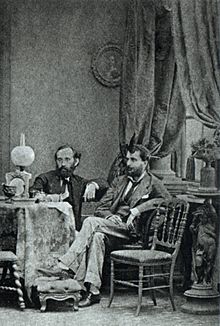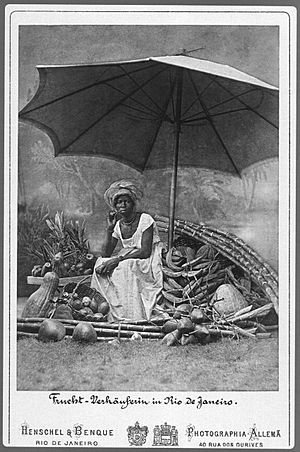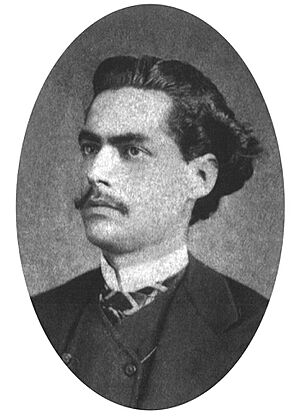Alberto Henschel facts for kids
Alberto Henschel (born June 13, 1827, died June 30, 1882) was a famous German-Brazilian photographer. He was born in Berlin, Germany. Henschel is known as one of the busiest photographers and business owners in 19th-century Brazil. He had photo studios in major cities like Pernambuco, Bahia, Rio de Janeiro, and São Paulo. He also helped other professional photographers, like Karl Ernst Papf, come to Brazil.
Henschel became well-known for his beautiful landscape photos of Rio de Janeiro. He was also excellent at taking portraits of people. He earned the special title of Photographo da Casa Imperial, which means Photographer of the Royal House. This allowed him to photograph the daily life of the Brazilian royal family during the time of Emperor Pedro II. He even took pictures of the Emperor and his family! This important title made his photos more famous and valuable.
But Alberto Henschel's most important contribution was his collection of photos showing different kinds of people in Brazil in the 1800s. He took portraits, often in a small size called carte de visite. He photographed rich people, business owners, middle-class families, and also black people, including those who were enslaved and those who were free. He did this before slavery was officially ended in Brazil by the Lei Áurea. His photos are special because he showed these individuals with respect and dignity.
Contents
Life of a Photographer
Early Life in Germany
Alberto Henschel was born on June 13, 1827, in Berlin. His family, the Henschels, were known as engravers. We don't have many details about his early life or why he decided to move to Brazil. It's thought that he might have met another photographer, Francisco Benque, in Germany. They later worked together successfully in Brazil.
Starting in Brazil
The 1860s: New Beginnings
In May 1866, Henschel arrived in Recife, Brazil, with his business partner Karl Heinrich Gutzlaff. They planned to open a photography studio. Their first studio was called Alberto Henschel & Cia, but it later became Photographia Allemã (meaning German Photography). Henschel quickly built up his business. This suggests he was already an experienced photographer who saw a great opportunity in Brazil, where photography was still quite new.
In 1867, Henschel went back to Germany for a short time. He wanted to learn new photography techniques and buy better equipment for his studio. When he returned to Brazil later that year, he opened another studio in Salvador. Opening three studios in just two years showed that Henschel was a very bold and smart businessman in Brazil's photography world.
By the late 1860s, Henschel's studios in Recife and Salvador were already taking portraits of people of African origin. This included both enslaved and free individuals. Henschel was different from other photographers because he showed these people freely and with dignity, treating them as individuals, not just objects.
The 1870s: Royal Recognition
In 1870, Henschel opened another studio in Rio de Janeiro, which was the capital city at the time. Here, he started a successful partnership with Francisco Benque. Their studio, called Henschel & Benque, focused on portraits and landscapes. They also sold special "photopaintings" made by Karl Ernst Papf, who had come to Brazil because of Henschel. Their partnership likely lasted until about 1880.
Because of the high quality of his work, Henschel became very successful in the capital. On September 7, 1874, he and Benque received the special title of Photographo da Casa Imperial (Photographer of the Royal House). This important title made their photographs even more recognized and valuable.
Henschel also showed his photos in many exhibitions. He did very well at the Imperial Academy of Fine Arts exhibitions in 1872 and 1875. He even won a Gold Medal in the first one! He also participated in international exhibitions, like the Universal Exposition in Vienna, Austria, where he received a Merit Medal.
The 1880s: New Horizons
On February 1, 1882, Henschel opened another studio, this time in São Paulo. He named it Photographia Imperial (Imperial Photography). His arrival in São Paulo was a big deal because he held the respected title of Photographer of the Royal House. Local newspapers, like A Província de São Paulo, wrote about how excited the people of São Paulo were to have him.
Sadly, Henschel died in Rio de Janeiro just a few months after opening his São Paulo studio. However, his photography businesses continued to operate for many years under the management of other people. They kept using the "Henschel" name because it had become so famous and respected.
Photography Techniques
Alberto Henschel was known as the most active photographer and businessman in 19th-century Brazil. He always kept up with the newest photography techniques. For example, when the carte de visite photo format became popular, Henschel was already an expert at it and used it often in his studios.
His studios had the latest equipment. This included special tools for taking quick portraits of children. Children were often hard to photograph because they wouldn't stay still!
Henschel photographed all kinds of people in Brazil during the 1800s. Besides the Brazilian royal family and black people, he also took pictures of noble families, wealthy merchants, and the white middle-class. His work gives us a wonderful look into what life was like for many different groups of people in Brazil long ago.
Images for kids
-
Xylography of an armadillo, one of the most exotic animals seen by Hans Staden in Brazil (1557)






